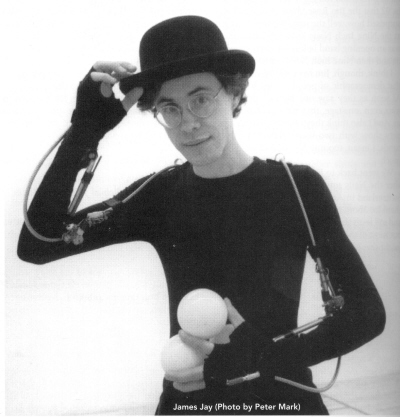
James Jay (Photo by Peter Mark) |
Page 24 Spring 1996
|
Cyber-Juggling:
James Jay's Juggling Jukebox
! BY PETER D. MARK
Ever
since Shelley's Frankenstein, the idea of
In
1960, two scientists, Manfred Clynes and Nathan Kline, coined the
term "cyborg" (short for cybernetic organism) in a paper entitled "Psychophysiological Aspects of Space Flight" in which they argued that a "self-regulating man-machine system" (a cyborg) might be essential for survival in extraterrestrial environments.
Since
then, cyborgian images have infused popular culture: comic books
(X-Men), TV shows (Six Million Dollar Man), films (Robocob, Johnny
Nmemonic), and countless works of science fiction. The phenomenon is
so pervasive that a vast compendium entitled "The Cyborg
Handbook" (edited by Chris Hables Gray) has recently appeared
that catalogues these and other matters cyborgian. As exhaustive as
this 540-page tome is, it's missing an entry: the Juggling Jukebox.
The
Juggling Jukebox is the embodiment of a vision of James Jay, a
Seattle sculptor, graphic artist and juggler, and Bret Battey, a
Seattle composer. Jay performs two versions of the Jukebox:
high-tech and low.
The high-tech version is a multimedia mixture of musical sounds, flashing lights and juggling. Performing at large public gatherings such as Bumbershoot, the annual Seattle Arts Festival, Jay stands on a raised platform, clad in black, tilted forward, motionless and expressionless, until a viewer (often a child) inserts money into the coin/bill acceptor on the adjacent hand-built "vending" machine and pushes a button to select a "song." The "user" can choose from a list of eight songs with such titles as "Water Clock," "Ionic Collonade," and "Astrolabe #7" with a corresponding list of price options: $1I for a three-ball routine, $2 for four balls, and $5 for five balls. (The lowtech version offers additional choices: 25 cents for one ball, 50 cents for two balls, and $99 for seven balls. Jay actually can do seven balls, but so far no one has taken him up on it.) |

James Jay (Photo by Peter Mark) |